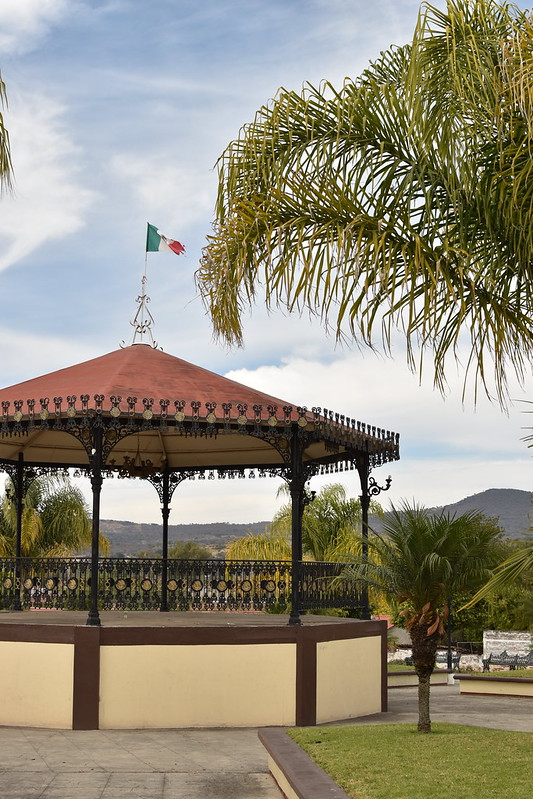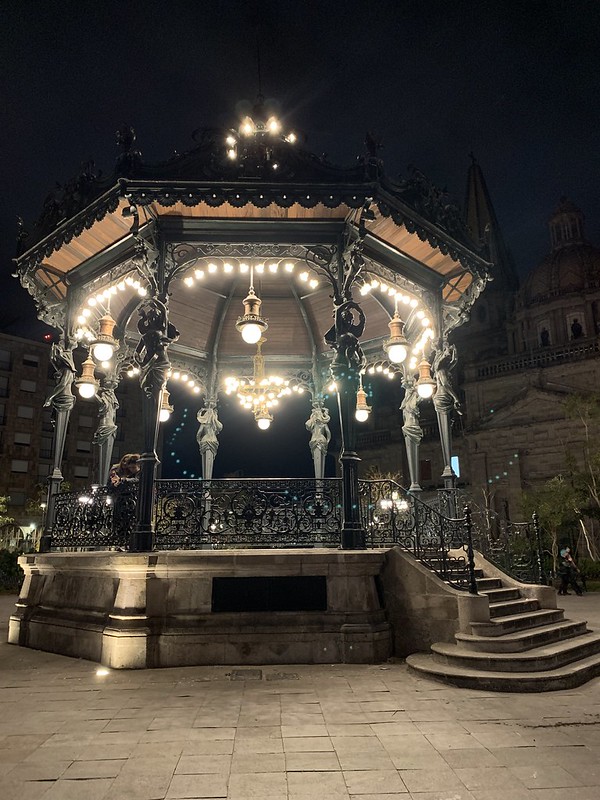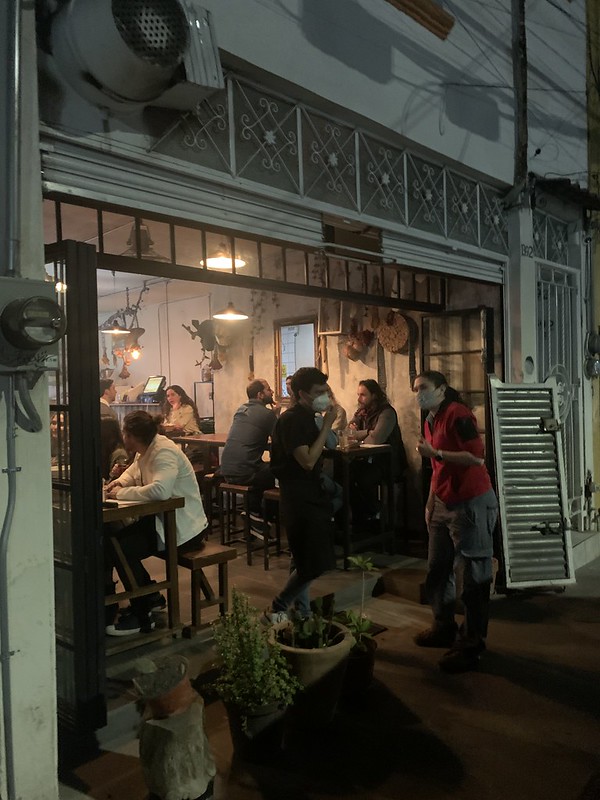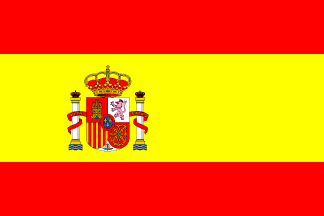
I’m going to continue the tradition of bitching about WordPress—they removed the theme I’d used for years so when I tried out another one momentarily I was unable to go back and wound up trapped in this theme that breaks all kinds of formatting I did before. Which is something of a relief in a sense because now the fact that I can’t embed the flag the way I used to isn’t so much of an issue because none of the embedded flag graphics show up embedded properly anyway. I’m really glad I’m not paying for WordPress here.
Anyway—now that I have that out of my system, I went to Mexico again. More or less the same itinerary for the work part of it as last time, but I went some different places at the end, and the company was a bit different. This time I was joined by D, a co-worker from here in California. She’s made a couple trips to Mexico with me over the years but this was the first this year and the first time she got to spend any significant amount of time Guadalajara, so I was kind of psyched to show her some of my favorite places.
I’ve basically given up on my grudge against Volaris, since they always seem to be the most convenient option for my flights to Mexico. We flew from San Jose on a mostly empty flight—there were several empty rows on either side of us, but for some reason I’d be stuck in row with two other people next to me, and D had one next to her despite all the empty space. Luckily they let us move after people had boarded, so we moved back a row. It was rather nice to spread out. I got the clever idea of attaching my GoPro to the window shade to take a time lapse of the flight, which I still think is a fun idea, but the clip didn’t want to hold—I need to bring my suction cup if I’m going to pull that off.
We landed around 8 and headed to our hotel, the Ramada Encore in Tlajomulco, which is our usual first night hotel as it’s on the way out of town. We checked in quickly and I went up and threw down my stuff and headed back down to enjoy my complementary beverage at the hotel bar. Usually I get the frozen margarita but they didn’t seem to have it as an option, so I had a glass of red wine instead. I’d downed about half of it when D appeared, and we headed out to find dinner at the Gourmeteria next door. We settled on La Hamburgueria, enjoyed our dinner and headed back.
When I went through security I’d noticed I forgot my bag of toiletries, and I really wanted at least a toothbrush, so I asked about it at the front desk (the first attempt got garbled in translation and resulted in someone trying to set up an airport shuttle for me) and they told me they didn’t have any, but that there was an Oxxo just up the street, so I walked over there and bought a toothbrush and toothpaste, and texted with my wife a bit on the walk back.
The next morning, we ate at the buffet-that-is-not-a-buffet and caught our ride to O’s house, then headed for Michoacan. The first stop was Purepero. The route to Purepero features the constant threat of protests blocking the road, so we decided to head there first so we could go by the highway and avoid them. That part worked, but the next part, as we headed to Tangancicuaro, was where it broke down. Soon after we hit the road, we came across a police roadblock, warning us that there was a protest blocking the road. So we made a change of plans and took an alternate route that I’d never traveled before.
We passed through the town of La Jabonera (“The Soapery”?), which had several strikingly large, nice houses in what appeared to be a small town in the middle of nowhere. We paused to use the grungy public bathroom in the pristine and very empty town square. The women’s restroom was padlocked, but the men’s was not only open but completely lacked a door, so O stood guard while D used it. I wandered around a bit, checked out the gazebo and the angular, modern church across the street.

We continued on to Tangancicuaro, checked out the fields there, and back to Zamora, where we checked into the Meson del Valle, our hotel. This time we were in the tower, which was always nice, as it tends to be quieter and the views are better. Just to see how it worked, I clipped my new action camera (an Akaso Brave 7) onto the curtain pull, and set up a time lapse view out the porch door (it wasn’t a particularly interesting view, just some buildings and water tower, but I thought it might be cool to see night fall and clouds scoot by).
We had dinner at the Gordo Grill in Zamora, and my after-dinner meeting with Australia got canceled, so we lingered for a long time, enjoying tacos, asparagus, bone marrow. I had a cocktail (unusual for me) with mezcal and pineapple, which was really nice, as well as sharing a bottle of wine. After desert, we headed to back to the hotel. I checked the camera and was pretty pleased with the results. I’m still adjusting to the sense of what I can do with this camera (and my older GoPro Hero4 Silver)—my mindset has never really shifted from just taking pictures with a standard camera, so I forget I can do things like time lapse, or underwater, or mount it on a car or things like that…so I keep bringing it on trips to so I can get used to thinking about it and the sense of possibilities. I’m still not sure why I need these cameras, but I do have fun with them, so they’re more toys than anything. Apparently I can’t post the video on WordPress without paying, and it’s not really worth it, so you’ll just need to trust me that it’s pretty cool.
The next morning we drove to Tapalpa, crossing the lakes like the last trip. There’s a surprising amount of water in them still—usually at this point in the season they are mostly dry, and it’s actually been a pretty dry winter up to this point, but the fall was super rainy, so I guess the lakes started the winter pretty full. There weren’t as many birds as last time, but we still saw black-necked stilts, avocets, northern shovelers, and lots of other ducks.

Things looked great in Tapalpa, although with the onslaught of Omicron in Mexico they had moved all the offices outside (this was the case in Tangancicuaro as well). The farm manager was outside in the shade shelter on his laptop interviewing a job candidate. Anyway, we checked things out there, and then sat down for another cup of Uruapan coffee before heading back to Tapalpa.
The last couple trips we’ve had a driver to take us back to Guadalajara from Tapalpa so that O can stay there to work the next day. The driver always shows up earlier than planned, so we don’t wind up spending that much time in Tapalpa (we probably could, but I often want to get to Guadalajara). One of these days I’m going to spend the night in Tapalpa and then explore more there—I’ve made a number of short visits to Tapalpa, but never really explored far beyond the main square and nearby streets.

A few times when I’ve been there I’ve seen people in the tower on the new church, but I could never figure out how they got there—usually in these churches there’s a stairway tucked away near the front door (usually it’s locked, but I figured if there were actually people up there maybe it wouldn’t be). But in this case I could find it. It turns out that the entrance isn’t inside the church—it’s outside. There’s actually an external “tube” with the staircase in it running up the back of the tower. Unfortunately it was padlocked, so I still couldn’t get in there, but now I know where it is. (There are public bathrooms back there, so when I went to check it out, people asked me if wanted to use the bathroom. I didn’t.)

After hanging out in Tapalpa a bit, D and I hopped in the car and headed back to Guadalajara. It always feels like it takes longer than it needs to from Tapalpa, but the hotel I’ve been staying at is right in the historic center, so there’s a lot of driving on downtown streets that doesn’t go super fast.
We checked into our hotel, Hotel Morales, which has been my base of operations for the last couple trips. I like it—it’s a historic building, once a mecca for celebrities in Guadalajara (the bull ring was nearby, and many famous matadors used to hang out in the bar), but most importantly, it’s also right by the historic center so it’s really convenient.
We had made reservations at a restaurant I’d never been to, called Xokol. It seemed to be getting a lot of interest from both local and foreign press, as a place making creative cuisine with traditional ingredients. I wasn’t sure we’d be in Guadalajara in time, but it turned out the restaurant was open until 11, and actually we weren’t able to get reservations until 10, so we had plenty of time. After checking in at about 7:30, dumped our stuff in our rooms and met up again downstairs, and decided to walk around a bit and go to Xokol on foot—about a 40 minute walk, but we had time.
People worry about Guadalajara at night (and maybe I should) but I’ve spent a lot of time walking around after dark and I’ve never really felt unsafe in the places I’ve gone. There are lots of people around, and the streets are reasonable well-lit. We walked up to the plazas surrounding the cathedral, which were bustling with people. We went past the cathedral to the north and stopped at the Rotonda de los Jaliscienses Ilustres, which honors the most significant citizens of Jalisco.

The central rotonda
There’s a central rotonda in the middle of the square, where many of the people are entombed (mostly after being exhumed from their original resting places), which you can’t enter, and then around the edge of the square are statues of the people honored. D was really interested in the people, so we made our way around and looked up a lot of them. Since the last time I spent much time looking at them, they’d added QR codes to them that could be scanned for more info. We were excited that one of the scientists, Leonardo Oliva, was holding a plant. It’s always nice when people actually recognize the value of what we do (or at least what Leonardo Oliva did, but I’ll take my imaginary accolades however I can get them).

After that we swung through the Plaza de Armas, and paused to see bullet hole in the clock on the state capital building, and the gazebo, covered in lights.

From here we made our way across town, down Avenida Juarez. I kind of enjoyed playing tour guide—this is the first time I’ve actually been in Guadalajara with someone I know. Generally I’ve wandered around alone, and the exceptions were with tour guides. It turns out I’ve actually absorbed a lot of information, which D gamely let me babble at her while we walked around (hopefully she enjoyed it). We stopped to look at the statue of Matute Remus moving the telephone office, and swung by the Barragan house with a restaurant in it (closed at that point) that I visited on my trip in November. Then we took a quick detour to see the Templo Expiatorio. It was closed, unfortunately, but there was a market in the square with lots of people around. It’s an interesting church, very different than most of the other churches in Mexico, very Gothic. The church was lit up beautifully—this is the first time I’d visited after dark.

Templo Expiatorio at night
This was basically as far as I’d wandered in this direction in Guadalajara, so from here on it was somewhat unknown territory. The restaurant was in Santa Tere (Santa Teresita) which has a reputation as kind of a hip, up and coming neighborhood, with lots of sort of foodie places. I had visited once, during the day, and visited the market, but not on foot. We quickly found ourselves walking on pretty empty streets. I kind of thought we would see more restaurants and bars when we got there, but it mostly seemed kind of closed down and empty (it turns out that the restaurants and bars are mostly a couple blocks to the north). We actually walked past the restaurant once (it didn’t seem to have a sign) but we doubled back and found it. We were a little early for our reservation, so we told them we were there and they seated us within a few minutes. It was a really small restaurant—I could understand the need for a reservation and the hour and forty minute time limit on the meal—it could maybe fit 15-20 people at most? We were actually seated at the end of a table with another group of people.

They brought us fresh tortillas and a spicy pepper paste to eat while we perused the menus. The tortillas were amazing—a mix of yellow, red, and blue corn and incredibly fresh.

D had a local beer, and I ordered a tepache de tejocote. Tepache is a fermented drink, more commonly made with pineapples (the original Nauhatl drink was made with corn, and the original name, tepiātl, means “drink made with corn”, so I had a drink made with corn without the corn). I ordered the one made with tejocote because I’d seen tejocotes in markets several time but had never tried them . These small fruits are rosaceaeous (always a plus in my book) and come from Crataegus mexicanus, the Mexican hawthorn. They’re a bit like little pears or crabapples, and have a long history in indigenous foods, eaten fresh, cooked, or, most-commonly, in drinks. Their name also derives from Nauhatl, texocotl, which means “stone fruit”. It was sweet and sour and really delicious. It came in a bottle with a hand-written tag, and was almost certainly made locally, maybe by the restaurant itself. I actually ordered a second one, but they brought me a tepache de piña, which was also good (but maybe not as good).

We ordered three mains—two vegetarian (D is vegetarian) and one with meat. We had a quesadilla of sorts, a bowl with cauliflower and greens and corn hummus, and beef lips. All of it was amazing.

After dinner, we called an Uber to take us back—one walk across Guadalajara was enough for the night. After getting back, I settled in to take my COVID test. I had brought a test with me that you can take online with a proctor that was acceptable for travel. I got out the test, sat down, and connected to the website. I had to make an account, which I did, and then I connected. A nice lady joined me online and checked my test, and then my ID. But she was concerned:
“This is maybe a very bad problem,” she said.
“What is?”
“You have a different name here on your ID. This is maybe a very bad problem.”
It turns out that apparently the presence of my middle name on my ID was the problem, because I didn’t have it on my account profile. The website had asked for First Name and Last Name and didn’t mention middle name, which is why I hadn’t entered a middle name. She recommended I log out and change it.
I logged out, but it turned out that the website wouldn’t allow me to modify my name. Eventually I downloaded the app and was able to change it there. So yay, another useless app. I reconnected and this time, instead of the nice Indian lady, I got someone having weird distortions. It sounded like he had been slowed way, way down…deep, slow, subhuman, hard to understand. He kept plowing ahead though, regardless of what I said. Finally I disconnected, and then reconnected. And then got the same guy. So I disconnected and waited ten minutes, and then tried again. This time I got Anita, who successfully shepherded me through the process. I was impressed how carefully they monitored all the steps of the testing process, and how little they did to the actual results, but I was happy to test negative, because I’d almost convinced myself I was going to be positive.
The next morning D and I headed out early to go to breakfast at the cafe at the Teatro Degollado. Which, despite claiming to be open at 7:30, was not in fact open. So we wandered around a little bit more and eventually wound up at La Chata, a relatively famous breakfast place, and ate there. It was really good, actually, though I was still a little bitter about the theatre.
After breakfast we wandered around the historic center, stopping at the Cathedral, and then to Arbol Adentro San Jose de Gracia, where we marveled at the tiny Inca Doves.

Then we headed to Hospicio Cabañas which, surprise, was not open when it said it would be. However there were lots of heavily armed police and police vehicles there, which was a little unsettling. We set out to see San Juan de Dios Market, got a little turned around, stopped in a nearby church, and eventually found it. We wandered around a lot, looking for fruit, before eventually finding it. It’s a huge market, but more stuff-focused than food-focused.

We decided to get some coffee, and went back to the cafe and Teatro Degollado. I thought we’d be able to look inside at 11am, but of course, like so many things, it didn’t open. But the coffee in the little French press was good and it was nice to relax a bit.
At last we went to Hospicio Cabañas. We didn’t have a lot of time left, so it was kind of quick, but I never get tired of visiting that place. D thought it reminded her of Dark Souls (I don’t know the game, but it sounds like it sort of fits). After enjoying the Orozco murals for a while, conscious of the time, we hurried back to our hotel, stopping for just a moment at Nuestra Señora de Aranzazu to marvel at its golden interior, before reclaiming our bags and hopping an Uber to the airport.
After a few complications with the Covid forms, we made it into the airport and onto the plane and headed home.



















 It wasn’t especially late, but I’d eaten on the plane and felt a little intimidated by the crowds on the main street. So I asked if the hotel bar was open. The woman who had gone in the car with me went to the bar and unlocked the door and offered me a few beer options. I chose Fiji Bitter. She took one for herself as well, locked up the bar, and asked if I wanted to sit outside. I hadn’t really anticipated her joining me, but whatever. We sat in white plastic chairs behind the hotel, facing the alley, and drank our beers, and she lit up a cigarette.
It wasn’t especially late, but I’d eaten on the plane and felt a little intimidated by the crowds on the main street. So I asked if the hotel bar was open. The woman who had gone in the car with me went to the bar and unlocked the door and offered me a few beer options. I chose Fiji Bitter. She took one for herself as well, locked up the bar, and asked if I wanted to sit outside. I hadn’t really anticipated her joining me, but whatever. We sat in white plastic chairs behind the hotel, facing the alley, and drank our beers, and she lit up a cigarette.



















































